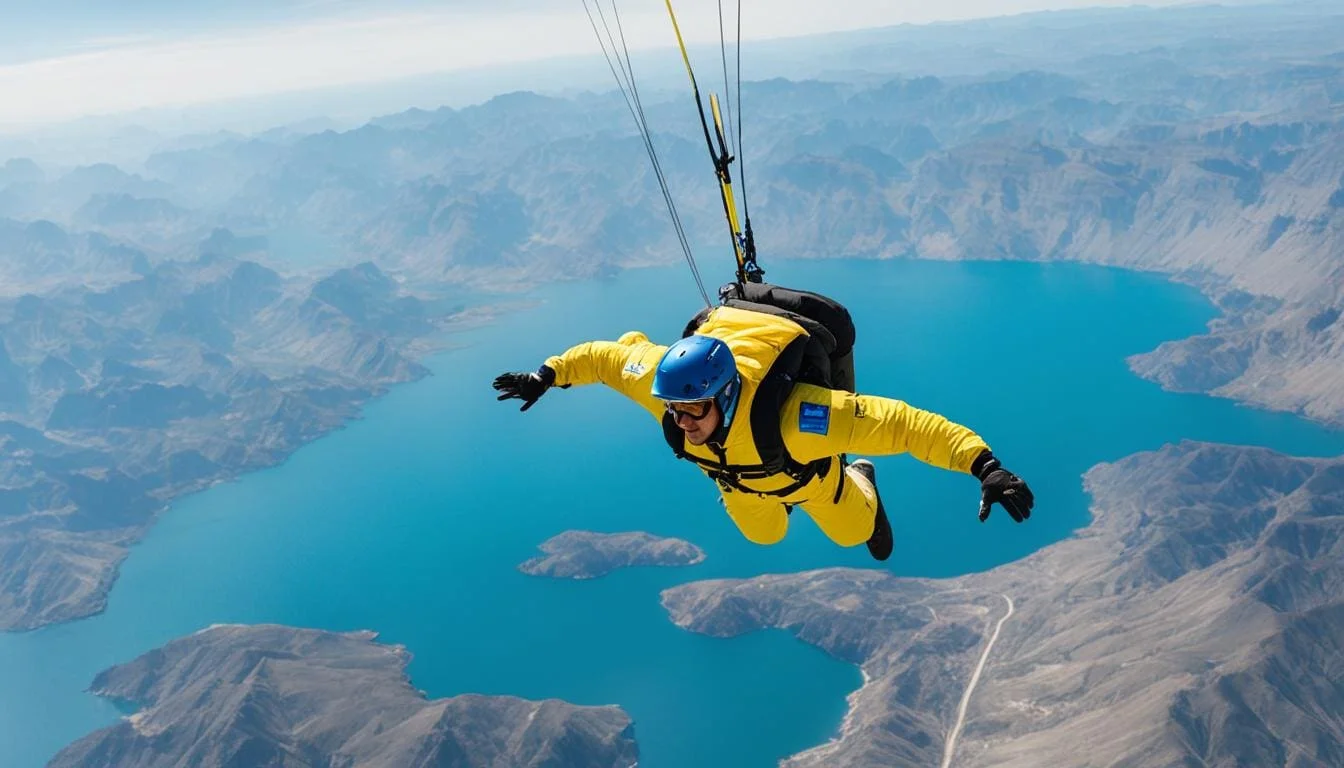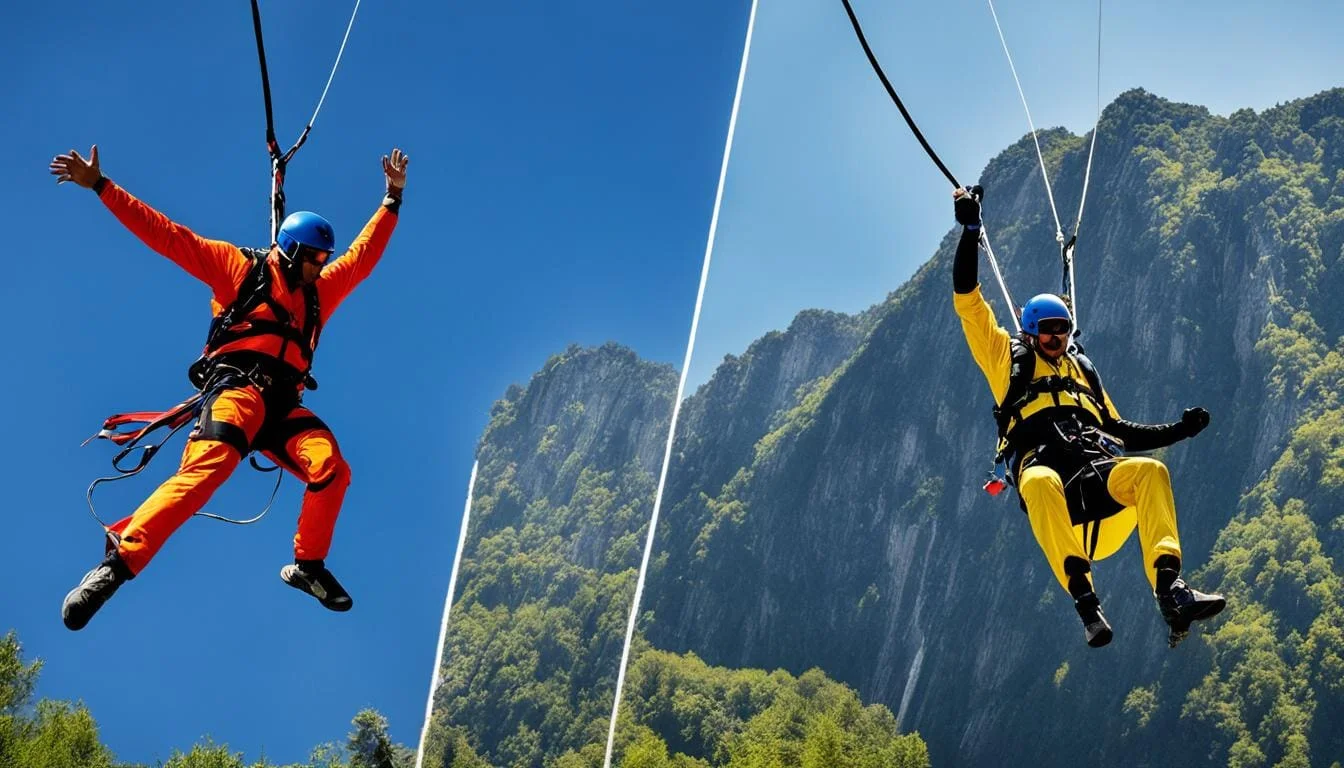BASE jumping is an extreme sport that involves jumping from fixed objects, such as buildings, antennae, spans (bridges), and cliffs (earth), and using a parachute to descend safely to the ground. In the world of adrenaline-fueled adventures, BASE jumping has captivated the hearts of daredevils worldwide. But is it recognized as an Olympic sport? Let’s delve into the intriguing world of BASE jumping and its connection to the esteemed Olympic Games.
While the ancient Greeks would have potentially welcomed BASE jumping as an Olympic sport, it has never been included in the Olympic Games. The Olympic Committee considers various criteria when selecting new sports, including the sport’s history, accessibility, popularity, relevance to the hosting nation, and the cost of hosting the event. Unfortunately, BASE jumping does not meet these criteria, as it is a relatively young sport with limited accessibility and lacks a widely recognized international governing body.
Key Takeaways:
Understanding BASE Jumping as a Sport
BASE jumping is an exhilarating sport that combines adrenaline, skill, and courage. In this section, we will explore the roots of BASE jumping, compare it to traditional skydiving, and delve into the equipment and techniques used by BASE jumpers.
The Roots of BASE Jumping
The origins of BASE jumping can be traced back to the 1960s when a group of skydivers started challenging the boundaries of traditional skydiving by jumping from fixed objects. These early pioneers, including Carl Boenish, pushed the limits of what was possible and paved the way for the creation of this extreme sport.

Comparison to Traditional Skydiving
While both BASE jumping and skydiving involve parachuting, they differ in significant ways. Skydiving typically takes place from an aircraft at high altitude, while BASE jumping involves jumping from much lower altitudes or fixed structures. This difference in altitude presents unique challenges for BASE jumpers, as they have less time to deploy their parachutes and must rely on precise timing and skill.
BASE Jumping Equipment and Techniques
BASE jumpers rely on specialized equipment designed for the unique demands of the sport. This includes a BASE-specific parachute system, which is typically smaller and more maneuverable than those used in skydiving. Additionally, BASE jumpers utilize wingsuits, which allow them to glide through the air, enhancing their control and creating a thrilling experience.
BASE jumping techniques vary depending on the type of object being jumped from. Jumpers must carefully assess the object’s height, landing area, and potential obstacles before making their leap. They also employ various techniques, such as tracking and freefall acrobatics, to maximize their enjoyment and safety during each jump.
| BASE Jumping Equipment | Description |
|---|---|
| BASE-Specific Parachute System | A smaller and more maneuverable parachute designed specifically for BASE jumping. |
| Wingsuit | An aerodynamic jumpsuit that allows the jumper to glide through the air, extending their flight time. |
| Helmet and Safety Gear | Protective equipment to ensure the jumper’s safety during the jump. |
| Rigging Tools | Tools used to set up the parachute system and ensure proper deployment. |
The Evolution and Recognition of Olympic Sports
Throughout history, the Olympic Games have continuously evolved and adapted to embrace new sports and disciplines. The Olympic Committee carefully considers various criteria when selecting sports for inclusion in the games, ensuring that each sport meets certain standards and contributes to the overall spirit of the Olympics.
Criteria for Olympic Sport Selection
The criteria for selecting new Olympic sports are rigorous and comprehensive. The Olympic Committee takes into account the sport’s history, accessibility, popularity, relevance to the hosting nation, and the cost of hosting the event.
1. History: The sport must have a rich and established history, demonstrating its significance and contributions to the world of athletics.
2. Accessibility: The sport should be accessible to a wide range of individuals and communities worldwide, allowing for widespread participation and interest.
3. Popularity: The sport’s popularity, both globally and within the hosting nation, is a key consideration. Sports with significant global followings and fan bases are more likely to be included in the Olympics.
4. Relevance: The sport should also be relevant to the hosting nation, showcasing cultural significance and resonating with the local population.
5. Cost: The cost of hosting the event is also taken into consideration, as the Olympic Games require significant infrastructure, facilities, and resources.
Recent Additions to the Olympic Games
In recent years, the Olympic Games have seen the addition of various sports that captivate audiences and bring excitement to the global stage. These recent additions demonstrate the Olympic Committee’s willingness to embrace new and exciting sports.
One notable example is the inclusion of rock climbing as an Olympic sport in the 2020 Tokyo Olympics. Rock climbing’s unique combination of strength, agility, and problem-solving skills has gained popularity among both athletes and spectators.
Another recent addition is surfing, which made its debut at the 2021 Tokyo Olympics. Surfing’s thrilling and dynamic nature, combined with its popularity worldwide, made it an exciting and welcomed addition to the Olympic Games.

| Year | New Sport | Reason for Inclusion |
|---|---|---|
| 2020 | Rock Climbing | Popularity and unique combination of physical and mental skills |
| 2021 | Surfing | Global appeal and exciting nature of the sport |
Is BASE Jumping an Olympic Sport
Despite its popularity and thrilling nature, BASE jumping has never been recognized as an Olympic sport. The sport does not meet the criteria set by the Olympic Committee for new sport selection, including its relatively short history, limited accessibility, and lack of a widely recognized international governing body. BASE jumping remains an independent and extreme sport, separate from the Olympic Games.
Challenges for BASE Jumping’s Olympic Aspiration
While BASE jumping continues to capture the attention of thrill-seekers and adrenaline enthusiasts worldwide, there are several significant challenges that hinder its aspirations of becoming an Olympic sport. These challenges encompass public perception, legal barriers, safety concerns, and accessibility.
Public Perception and Legal Barriers
The public perception of BASE jumping is often marked by skepticism and fear. Many individuals view it as an extreme and dangerous activity, which can create barriers to its acceptance as an Olympic sport. Additionally, the sport’s association with trespassing on private property and jumping from urban structures poses legal challenges in many jurisdictions. Authorities typically enforce strict laws and regulations to prevent unauthorized BASE jumping due to potential risks to jumpers and bystanders.
Safety Concerns and Accessibility
An inherent challenge to BASE jumping’s Olympic aspirations lies in the sport’s safety concerns. BASE jumping involves high-risk aerial maneuvers, and accidents can lead to severe injuries or fatalities. The safety aspect of the sport raises questions about its suitability for inclusion in the Olympic Games, which prioritize the well-being of athletes. Moreover, the accessibility of BASE jumping remains limited compared to more traditional Olympic sports. The specialized skills and equipment required, along with the geographical constraints associated with suitable jumping locations, make it a niche activity that is not easily accessible to the general public.
Despite these challenges, BASE jumping enthusiasts continue to push the boundaries of the sport and showcase their skills in major international competitions where they compete in various disciplines and set unconventional records.
| Challenges for BASE Jumping’s Olympic Aspiration | |
|---|---|
| 1. | Public Perception |
| 2. | Legal Barriers |
| 3. | Safety Concerns |
| 4. | Accessibility |
Competitive BASE Jumping on the Global Stage
While BASE jumping may not be an Olympic sport, there are competitive events within the sport that showcase the skills and abilities of BASE jumpers. These major international BASE jumping competitions attract participants from around the world who compete in various disciplines, pushing the boundaries of the sport.

Major International BASE Jumping Competitions
One prominent event in the BASE jumping community is the World BASE Race, which has been held annually since 2008. This competition challenges participants to achieve the fastest time from a fixed point to a landing area. Jumpers must navigate obstacles and use their skills to complete the course in the quickest time possible.
Another significant competition is the World Wingsuit League (WWL), which holds events in various countries. The WWL showcases the high-speed and adrenaline-fueled discipline of wingsuit flying, where jumpers soar through the air like flying squirrels, using specially designed suits to enhance their performance.
The Red Bull BASE Jumping World Series is another highly anticipated competition that takes place in multiple locations worldwide. This event attracts elite BASE jumpers who showcase their expertise in different categories, such as accuracy landing, style, and speed. The Red Bull BASE Jumping World Series offers a platform for jumpers to demonstrate their skills and compete against the best in the world.
Unconventional Records in BASE Jumping
BASE jumpers are known for pushing the limits of what is possible in the sport, and unconventional records often emerge through their audacious feats. These records include unprecedented jumps from iconic landmarks, record-breaking jumps with unique equipment, and world records for consecutive jumps within a certain time period.
One notable unconventional record is the highest BASE jump, which was set by Felix Baumgartner in 2012. Baumgartner jumped from a height of 39,045 meters (128,100 feet), breaking the sound barrier during freefall. This record-breaking jump captured the world’s attention and showcased the extreme nature of BASE jumping.
Another extraordinary record is the longest wingsuit flight, achieved by Jarno Cordia in 2014. Cordia flew for an astonishing 16 minutes and 43 seconds, covering a distance of 29.5 kilometers (18.3 miles) in the process. This remarkable achievement highlighted the skill and discipline required to successfully navigate the air currents.
These unconventional records inspire and motivate BASE jumpers to continuously push their boundaries, seeking new and daring ways to achieve extraordinary feats in the sport.
Conclusion
In conclusion, BASE jumping is not recognized as an Olympic sport. Despite its popularity and the existence of competitive events within the sport, BASE jumping does not meet the selection criteria set by the Olympic Committee. The sport’s challenges, including negative public perception, legal barriers, safety concerns, and limited accessibility, contribute to its exclusion from the Olympic realm.
While BASE jumping enthusiasts continue to push the boundaries of the sport, participating in major international competitions and setting unconventional records, BASE jumping remains an independent and extreme activity separate from the Olympic Games. Its thrilling nature and dedicated community ensure that the sport will continue to thrive outside of the Olympic arena.
In summary, BASE jumping continues to captivate the adventurous souls who dare to leap from great heights. Though it may not be an Olympic sport, BASE jumping remains a testament to human bravery and the pursuit of adrenaline-fueled experiences. As the sport evolves and gains further recognition, who knows what the future holds for BASE jumping on a global scale?




Leave a Reply